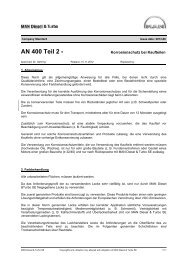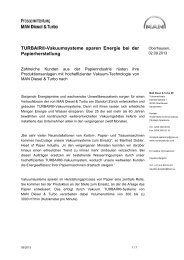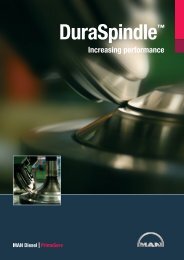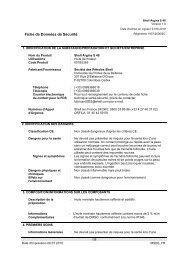BASF Glysacorr P113-EN - MAN Diesel & Turbo
BASF Glysacorr P113-EN - MAN Diesel & Turbo
BASF Glysacorr P113-EN - MAN Diesel & Turbo
You also want an ePaper? Increase the reach of your titles
YUMPU automatically turns print PDFs into web optimized ePapers that Google loves.
Safety data sheet<br />
Page: 1/8<br />
<strong>BASF</strong> Safety data sheet according to Regulation (EC) No. 1907/2006<br />
Date / Revised: 26.08.2009 Version: 1.1<br />
Product: <strong>Glysacorr</strong>* P 113<br />
(30278797/SDS_G<strong>EN</strong>_EU/<strong>EN</strong>)<br />
Date of print 27.08.2009<br />
1. Substance/preparation and company identification<br />
<strong>Glysacorr</strong>* P 113<br />
Use: Coolant concentrate<br />
Company:<br />
<strong>BASF</strong> SE<br />
67056 Ludwigshafen<br />
GER<strong>MAN</strong>Y<br />
Automotive and Refinery Chemicals<br />
Telephone: +49 621 60-93571<br />
Telefax number: +49 621 60-41517<br />
E-mail address: product-safety-auto-refinery@basf.com<br />
Emergency information:<br />
International emergency number:<br />
Telephone: +49 180 2273-112<br />
2. Hazard identification<br />
According to REGULATION (EC) No 1272/2008 on classification, labelling and packaging of<br />
substances and mixtures<br />
Label elements and precautionary statement:<br />
Pictogram:<br />
Signal Word:<br />
Warning<br />
Hazard Statement:
Page: 2/8<br />
<strong>BASF</strong> Safety data sheet according to Regulation (EC) No. 1907/2006<br />
Date / Revised: 26.08.2009 Version: 1.1<br />
Product: <strong>Glysacorr</strong>* P 113<br />
(30278797/SDS_G<strong>EN</strong>_EU/<strong>EN</strong>)<br />
Date of print 27.08.2009<br />
Causes serious eye irritation. Causes skin irritation.<br />
Precautionary Statements (Prevention):<br />
Wear protective gloves/clothing and eye/face protection. Wash with plenty of water and soap<br />
thoroughly after handling.<br />
Precautionary Statements (Response):<br />
IF IN EYES: Rinse cautiously with water for several minuts. Remove contact lenses, if present and<br />
easy to do. Continue rinsing. IF ON SKIN: Wash with plenty of soap and water. If skin irritation occurs:<br />
Get medical advice/attention. If eye irritation persists: Get medical advice/attention. Take off<br />
contaminated clothing and wash before reuse. Specific treatment (see on this label).<br />
Classification of the substance and mixture:<br />
Skin corrosion/irritation: Cat. 2<br />
Serious eye damage/eye irritation: Cat. 2<br />
Possible Hazards<br />
Irritating to eyes and skin.<br />
3. Composition/information on ingredients<br />
Chemical nature<br />
Preparation based on: carboxylic acid, dicarboxylic acid, amine, in water<br />
Hazardous ingredients (GHS)<br />
according to Regulation (EC) No. 1272/2008<br />
3,5,5-trimethylhexanoic acid<br />
Content (W/W): > 10 % - < 15 %<br />
CAS Number: 3302-10-1<br />
EC-Number: 221-975-0<br />
Hazardous ingredients<br />
according to Directive 1999/45/EC<br />
3,5,5-trimethylhexanoic acid<br />
Content (W/W): > 10 % - < 15 %<br />
CAS Number: 3302-10-1<br />
EC-Number: 221-975-0<br />
Hazard symbol(s): Xn<br />
R-phrase(s): 22, 36<br />
Acute tox.: Cat. 4 (oral)<br />
Eye dam./irr.: Cat. 2<br />
The wording of the hazard symbols and R-phrases is specified in chapter 16 if dangerous ingredients<br />
are mentioned.
Page: 3/8<br />
<strong>BASF</strong> Safety data sheet according to Regulation (EC) No. 1907/2006<br />
Date / Revised: 26.08.2009 Version: 1.1<br />
Product: <strong>Glysacorr</strong>* P 113<br />
(30278797/SDS_G<strong>EN</strong>_EU/<strong>EN</strong>)<br />
Date of print 27.08.2009<br />
4. First-Aid Measures<br />
General advice:<br />
Immediately remove contaminated clothing.<br />
If inhaled:<br />
If difficulties occur after vapour/aerosol has been inhaled, remove to fresh air and seek medical<br />
attention.<br />
On skin contact:<br />
Wash thoroughly with soap and water.<br />
On contact with eyes:<br />
Immediately wash affected eyes for at least 15 minutes under running water with eyelids held open,<br />
consult an eye specialist.<br />
On ingestion:<br />
Rinse mouth immediately and then drink plenty of water, seek medical attention.<br />
Note to physician:<br />
Treatment: Treat according to symptoms (decontamination, vital functions), no known specific<br />
antidote.<br />
5. Fire-Fighting Measures<br />
Suitable extinguishing media:<br />
water spray, dry extinguishing media, foam<br />
Specific hazards:<br />
harmful vapours<br />
Evolution of fumes/fog. The substances/groups of substances mentioned can be released in case of<br />
fire.<br />
Further information:<br />
Contaminated extinguishing water must be disposed of in accordance with official regulations.<br />
6. Accidental Release Measures<br />
Personal precautions:<br />
Use personal protective clothing.<br />
Environmental precautions:<br />
Contain contaminated water/firefighting water. Do not discharge into drains/surface<br />
waters/groundwater.
Page: 4/8<br />
<strong>BASF</strong> Safety data sheet according to Regulation (EC) No. 1907/2006<br />
Date / Revised: 26.08.2009 Version: 1.1<br />
Product: <strong>Glysacorr</strong>* P 113<br />
(30278797/SDS_G<strong>EN</strong>_EU/<strong>EN</strong>)<br />
Date of print 27.08.2009<br />
Methods for cleaning up or taking up:<br />
For large amounts: Pump off product.<br />
For residues: Pick up with suitable absorbent material. Dispose of absorbed material in accordance<br />
with regulations.<br />
Additional information: High risk of slipping due to leakage/spillage of product.<br />
7. Handling and Storage<br />
Handling<br />
No special measures necessary provided product is used correctly.<br />
Protection against fire and explosion:<br />
No special precautions necessary.<br />
Storage<br />
Further information on storage conditions: Keep container tightly closed and in a cool place.<br />
Protect from temperatures below: -10 °C<br />
Protect from temperatures above: 50 °C<br />
8. Exposure controls and personal protection<br />
Components with workplace control parameters<br />
102-71-6: 2,2',2"-nitrilotriethanol (Content (W/W): > 10 % - < 20 %)<br />
Personal protective equipment<br />
Respiratory protection:<br />
Respiratory protection in case of vapour/aerosol release. Particle filter with medium efficiency for solid<br />
and liquid particles (e.g. <strong>EN</strong> 143 or 149, Type P2 or FFP2)<br />
Hand protection:<br />
Chemical resistant protective gloves (<strong>EN</strong> 374)<br />
Suitable materials short-term contact and/or splashes (recommended: At least protective index 2,<br />
corresponding > 30 minutes of permeation time according to <strong>EN</strong> 374)<br />
butyl rubber (butyl) - 0.7 mm coating thickness<br />
nitrile rubber (NBR) - 0.4 mm coating thickness<br />
Supplementary note: The specifications are based on tests, literature data and information of glove<br />
manufacturers or are derived from similar substances by analogy. Due to many conditions (e.g.<br />
temperature) it must be considered, that the practical usage of a chemical-protective glove in practice<br />
may be much shorter than the permeation time determined through testing.<br />
Manufacturer's directions for use should be observed because of great diversity of types.
Page: 5/8<br />
<strong>BASF</strong> Safety data sheet according to Regulation (EC) No. 1907/2006<br />
Date / Revised: 26.08.2009 Version: 1.1<br />
Product: <strong>Glysacorr</strong>* P 113<br />
(30278797/SDS_G<strong>EN</strong>_EU/<strong>EN</strong>)<br />
Date of print 27.08.2009<br />
Eye protection:<br />
Safety glasses with side-shields (frame goggles) (e.g. <strong>EN</strong> 166)<br />
Body protection:<br />
Body protection must be chosen depending on activity and possible exposure, e.g. apron, protecting<br />
boots, chemical-protection suit (according to <strong>EN</strong> 14605 in case of splashes or <strong>EN</strong> ISO 13982 in case of<br />
dust).<br />
General safety and hygiene measures:<br />
Handle in accordance with good industrial hygiene and safety practice. Wearing of closed work<br />
clothing is required additionally to the stated personal protection equipment.<br />
9. Physical and Chemical Properties<br />
Form: liquid<br />
Colour: yellow<br />
Odour: product specific<br />
pH value: approx. 8.5<br />
(100 g/l)<br />
(ASTM D1287)<br />
Melting point: < -13 °C (DIN ISO 3016)<br />
Boiling point: > 100 °C<br />
(1,013 hPa)<br />
(ASTM D1120)<br />
Flash point: > 100 °C<br />
Flammability: does not ignite<br />
Ignition temperature: > 200 °C (DIN 51794)<br />
Explosion hazard: not explosive<br />
Vapour pressure: 20 hPa<br />
(20 °C)<br />
107 hPa<br />
(50 °C)<br />
Density: 1.10 g/cm3<br />
(20 °C)<br />
Solubility in water: readily soluble<br />
Hygroscopy: Non-hygroscopic<br />
Viscosity, kinematic: approx. 12 mm2/s<br />
(23 °C)<br />
10. Stability and Reactivity<br />
(DIN 51757)<br />
Thermal decomposition: No decomposition if used as directed.<br />
Hazardous reactions:<br />
No hazardous reactions when stored and handled according to instructions.
Page: 6/8<br />
<strong>BASF</strong> Safety data sheet according to Regulation (EC) No. 1907/2006<br />
Date / Revised: 26.08.2009 Version: 1.1<br />
Product: <strong>Glysacorr</strong>* P 113<br />
(30278797/SDS_G<strong>EN</strong>_EU/<strong>EN</strong>)<br />
Date of print 27.08.2009<br />
Hazardous decomposition products:<br />
No hazardous decomposition products if stored and handled as prescribed/indicated.<br />
11. Toxicological Information<br />
Acute toxicity<br />
Experimental/calculated data:<br />
LD50 rat (oral): > 2,000 mg/kg<br />
The product has not been tested. The statement has been derived from the properties of the individual<br />
components.<br />
Irritation<br />
Experimental/calculated data:<br />
Skin corrosion/irritation rabbit: Irritant. (OECD Guideline 404)<br />
Serious eyes damages/irritation rabbit: Irritant. (OECD Guideline 405)<br />
Other relevant toxicity information<br />
Because of the pH-value, it can be provisionally labelled as 'Irritant'.<br />
12. Ecological Information<br />
Ecotoxicity<br />
Toxicity to fish:<br />
LC50 (96 h) > 100 mg/l, Fish<br />
The product has not been tested. The statement has been derived from the properties of the individual<br />
components.<br />
Persistence and degradability<br />
Assessment biodegradation and elimination (H2O):<br />
The substance can be virtually eliminated from water in suitable effluent treatment plants by<br />
biodegradation, stripping and mechanical separation.<br />
13. Disposal Considerations<br />
Must be dumped or incinerated in accordance with local regulations.<br />
Contaminated packaging:<br />
Uncontaminated packaging can be re-used.<br />
Packs that cannot be cleaned should be disposed of in the same manner as the contents.
Page: 7/8<br />
<strong>BASF</strong> Safety data sheet according to Regulation (EC) No. 1907/2006<br />
Date / Revised: 26.08.2009 Version: 1.1<br />
Product: <strong>Glysacorr</strong>* P 113<br />
(30278797/SDS_G<strong>EN</strong>_EU/<strong>EN</strong>)<br />
Date of print 27.08.2009<br />
14. Transport Information<br />
Land transport<br />
ADR<br />
RID<br />
Inland waterway transport<br />
ADNR<br />
Sea transport<br />
IMDG<br />
Air transport<br />
IATA/ICAO<br />
15. Regulatory Information<br />
Not classified as a dangerous good under transport regulations<br />
Not classified as a dangerous good under transport regulations<br />
Not classified as a dangerous good under transport regulations<br />
Not classified as a dangerous good under transport regulations<br />
Not classified as a dangerous good under transport regulations<br />
Regulations of the European union (Labelling) / National legislation/Regulations<br />
Directive 1999/45/EC ('Preparation Directive'):<br />
Hazard symbol(s)<br />
Xi Irritant.<br />
R-phrase(s)<br />
R36/38 Irritating to eyes and skin.<br />
Other regulations<br />
16. Other Information<br />
Full text of hazard symbols and R-phrases if mentioned as hazardous components in chapter 3:
Page: 8/8<br />
<strong>BASF</strong> Safety data sheet according to Regulation (EC) No. 1907/2006<br />
Date / Revised: 26.08.2009 Version: 1.1<br />
Product: <strong>Glysacorr</strong>* P 113<br />
(30278797/SDS_G<strong>EN</strong>_EU/<strong>EN</strong>)<br />
Date of print 27.08.2009<br />
Xn Harmful.<br />
22 Harmful if swallowed.<br />
36 Irritating to eyes.<br />
Vertical lines in the left hand margin indicate an amendment from the previous version.<br />
The data contained in this safety data sheet are based on our current knowledge and experience and<br />
describe the product only with regard to safety requirements. The data do not describe the product's<br />
properties (product specification). Neither should any agreed property nor the suitability of the product for<br />
any specific purpose be deduced from the data contained in the safety data sheet. It is the responsibility of<br />
the recipient of the product to ensure any proprietary rights and existing laws and legislation are observed.
















